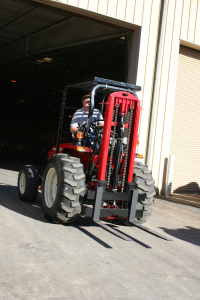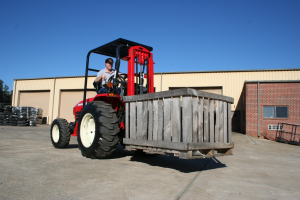
Working together, a Branson TM and a dealer took their idea for a unique tractor and turned it into an innovative new product for the company.
Bruce Sherer had an idea for a tractor. It wasn't a new idea, exactly, but something he'd been building his entire life. Growing up on a large fruit and vegetable farm, Sherer and his brothers spent their days tinkering with old Farmalls and Allis-Chalmers and converting them into makeshift forklifts to use for handling product.
"They worked pretty well, considering," says Sherer, recognizing the limitations of the machines. Sherer's original forklifts were restricted by 25-horsepower gas engines and 4-speed, 2WD transmissions. "They had a dry clutch that would burn out about 6 times a year," he says. "It was inferior, but it was all we had to work with."
Now that Sherer is grown up and a territory manager for Branson Tractors, he has a few more resources at hand. He'd been turning over the idea of revisiting his modified tractor for a while, and when he saw trend lines pointing toward fruit and vegetable growers having a strong year in 2009, he put his plan into action.
Recognizing the suitability of Branson's 35- and 47-horsepower models with their hydrostatic transmissions, Sherer contacted the company and requested to be sent a tractor that he could transform. He was confident enough in his idea that he offered his own collateral: if Branson didn't like what he did with it, he was prepared to purchase the tractor himself.
Branson went for it.
To manufacture the parts and build the first prototype, Sherer enlisted the help of Pat Herman, a 28-year old Branson dealer from Suttons Bay, Mich. In terms of background, Herman was the perfect candidate. His dealership is located in prime orchard country and he already ran a lucrative business servicing the machines used by local growers. Not only that, but Herman had his own experience in converting tractors into forklifts.
"He's built a lot of tractors like I did to into forklifts," Sherer says. "He already had the concept and knew how to do it, but we had to do it with the new tractor. So he had the background, the history and the knowledge."

Herman was excited when approached with the prospect of manufacturing the machine. Not only did he have the experience, but Sherer says he couldn't have asked for someone with more drive.
"He's very aggressive," says Sherer. "I signed him as a Branson dealer about two years ago and knew that when he takes on a project that he gets after it and does it right. I couldn't think of a better man for the job."
Herman is a little more modest about his own role in the development of the new model.
"Bruce had the idea for the forklift and we just ran with it," Herman remembers. "It took about 60 days to finish the first prototype with three men working 14-hour days splitting time between the dealership and the tractor. We had one guy who devoted the whole two months."
The end result was the MTT 3510, or at least an early version of it. The prototype was a 35-horsepower model with an 8-foot mast (Branson has expanded the concept into an additional 47-hp unit and has increased the mast size to 10-feet across the board). Through trial and error, manufacturing and remanufacturing parts, Herman and Sherer's team had built the orchard machine they'd set out to. But through the field test and demonstration processes, the pair found another, unexpected, use for the unit.
"Even though we run the tractor backwards, the 3-point hitch remains intact," explains Sherer. This was a peculiarity of design at first, but after running some trials, Herman and Sherer recognized another application. "In under 30 minutes the forklift can be removed and a 3-point hitch implement can be installed. Now we have a reversed tractor that works for chopping, snow blowing, stump grinding — it can basically run any PTO-driven implement that that can be pushed instead of pulled."
With this discovery, Herman and Sherer began to see a whole range of dealership and rental yard applications. They felt that they had a winner.
Branson flew a team to Michigan and spent about three-fourths of the day driving the prototype and taking photos. The representatives from Branson, including the company's president, "fell in love with it," according to Sherer, and they spent the remaining quarter of the day figuring out how they were going to make this work.
By the end of day one, the two parties had hammered out a deal. Branson ordered 50 units, and Sherer didn't have to pony up the cash for the 35-horsepower unit he and Herman had converted.
Branson had a few minor adjustments, but apart from modifications to meet the American National Stardards Institute's (ANSI) requirements and getting the unit ready for ROPS/FOPS certification, the process ran smoothly.
Herman is manufacturing the kits to assemble the first 50 units now. From there he will ship them to Branson's Georgia facility where existing 35- and 47-horsepower tractors will be disassembled and reassembled as MTTs.
"From the time we proposed the idea to the time we entered into full production there was about a 3-month turnaround," says Herman. "We started building the prototype back in May and they'll be at the dealerships by the end of January."
"Before we get the first 50 built, we'll have all those sold and we'll be in the process of building 50 more," adds Sherer. "We pre-sold 20 of them without anything more than an idea in our heads and a picture of the prototype. We hadn't even set a price."
E.W. Muehlhausen, director of operations for Branson, predicts big things for the MTT. "A lot of growers are just attaching forks to worn-out equipment they have on hand, so we think there is a pent-up demand for something like this."
With that demand coupled with Branson's belief that the versatility of the MTT will lead them into new markets, the folks at Branson can't help but be excited when talking about the tractor that their dealer built.
"It isn't just a matter of fruits and vegetables having a good year," Muehlhausen adds. "We are providing the market with something that doesn't exist today. This started as an entrepreneurial effort, but once we recognized the opportunity we just couldn't pass it up."





